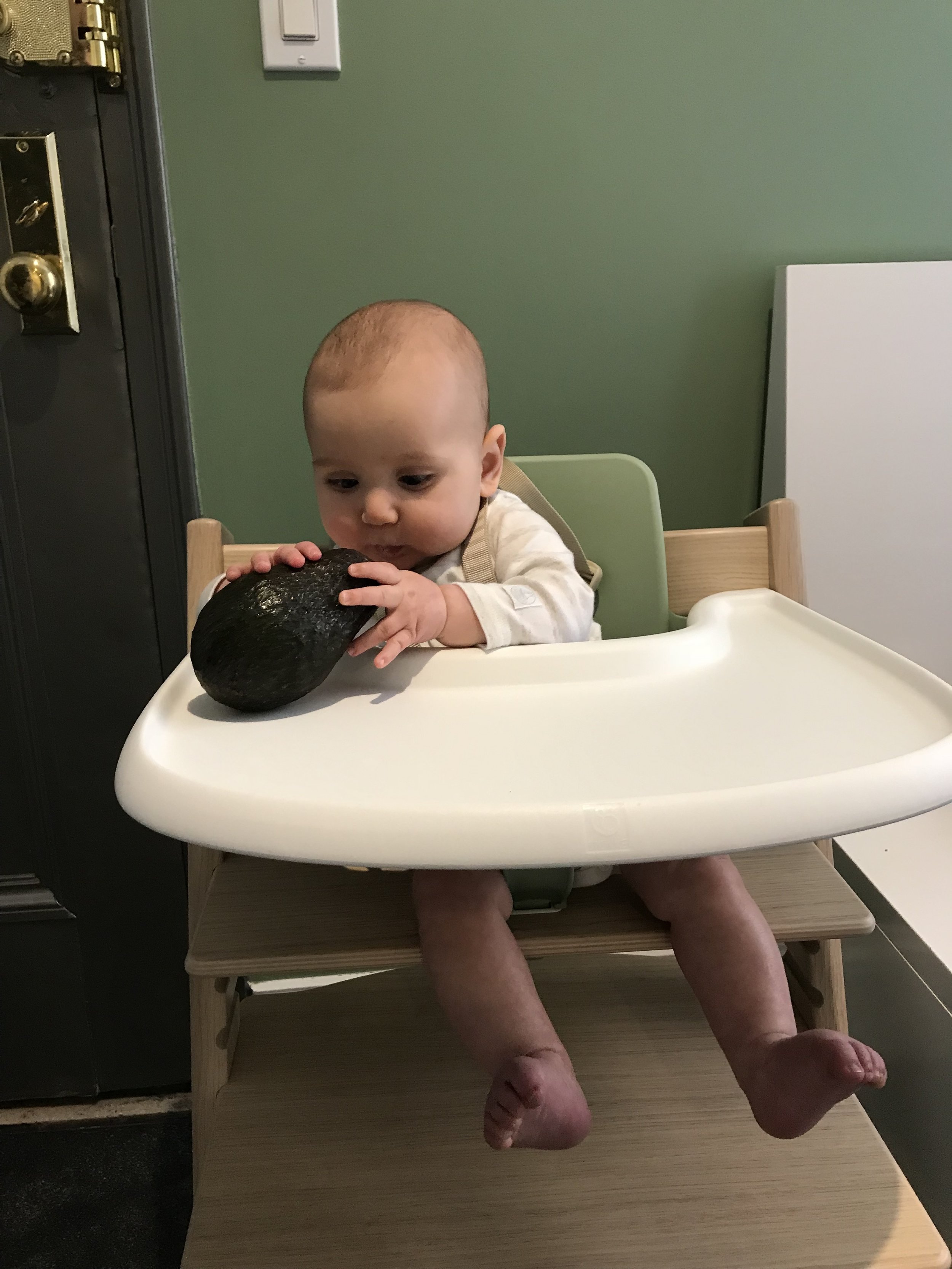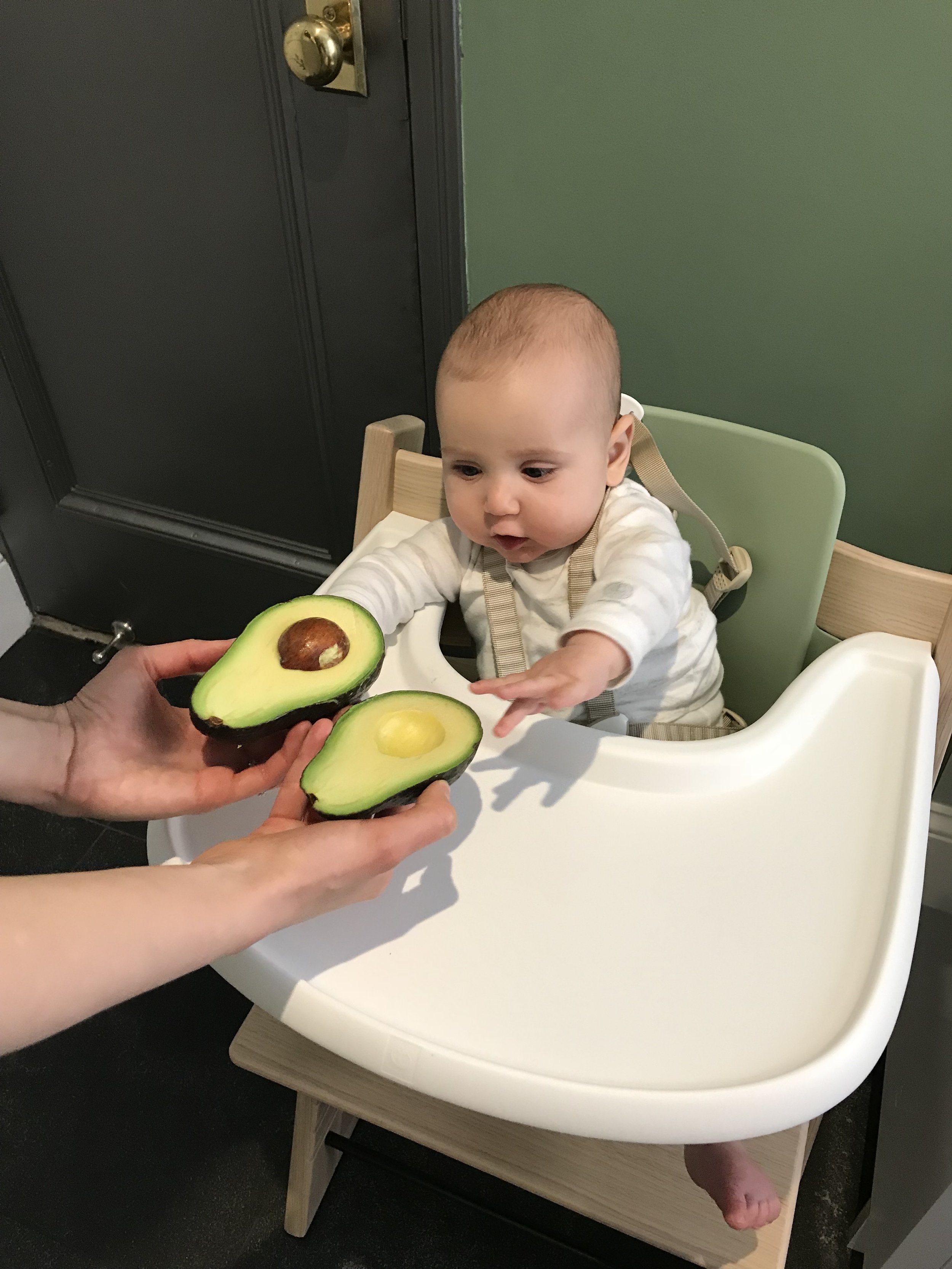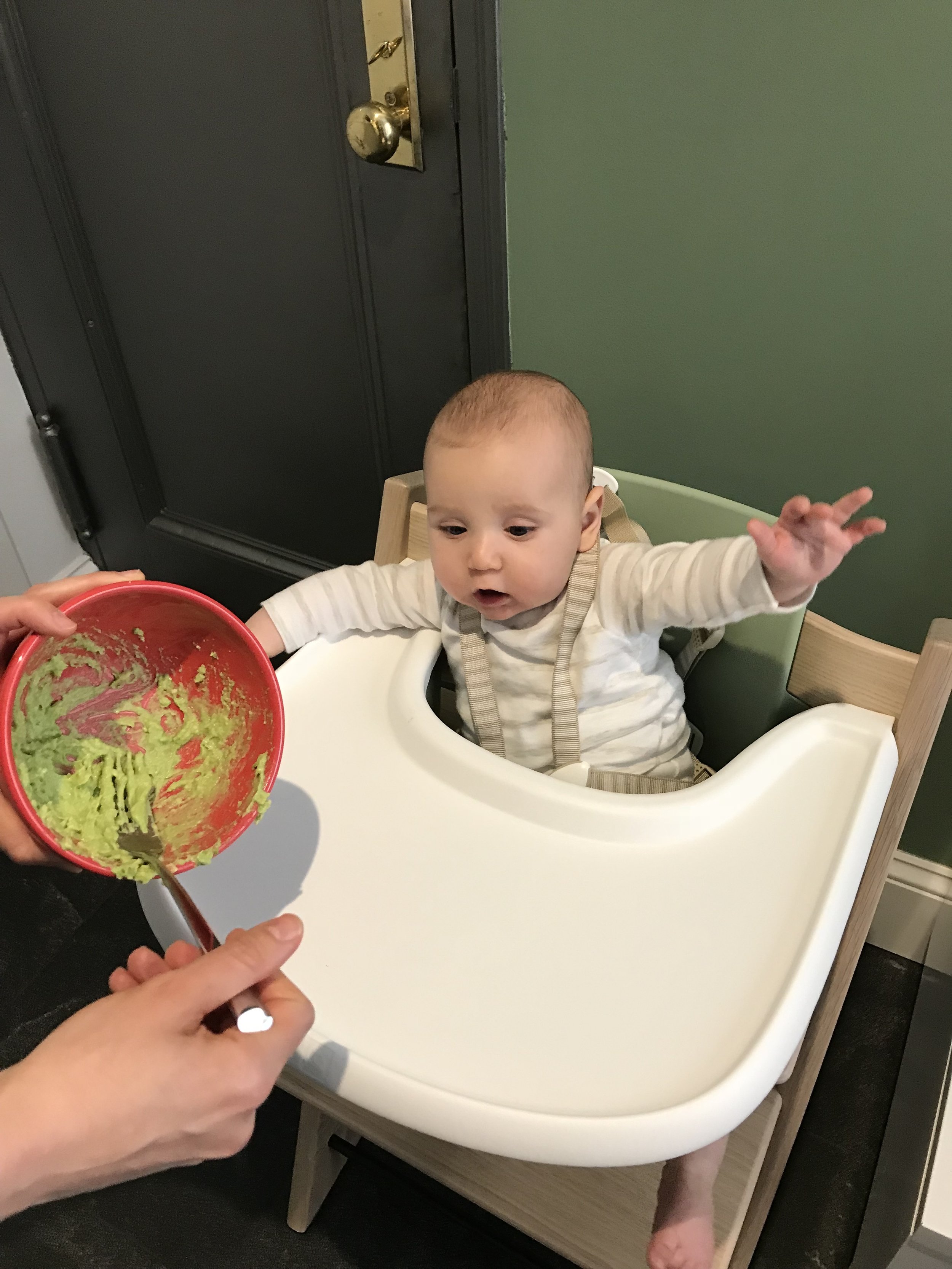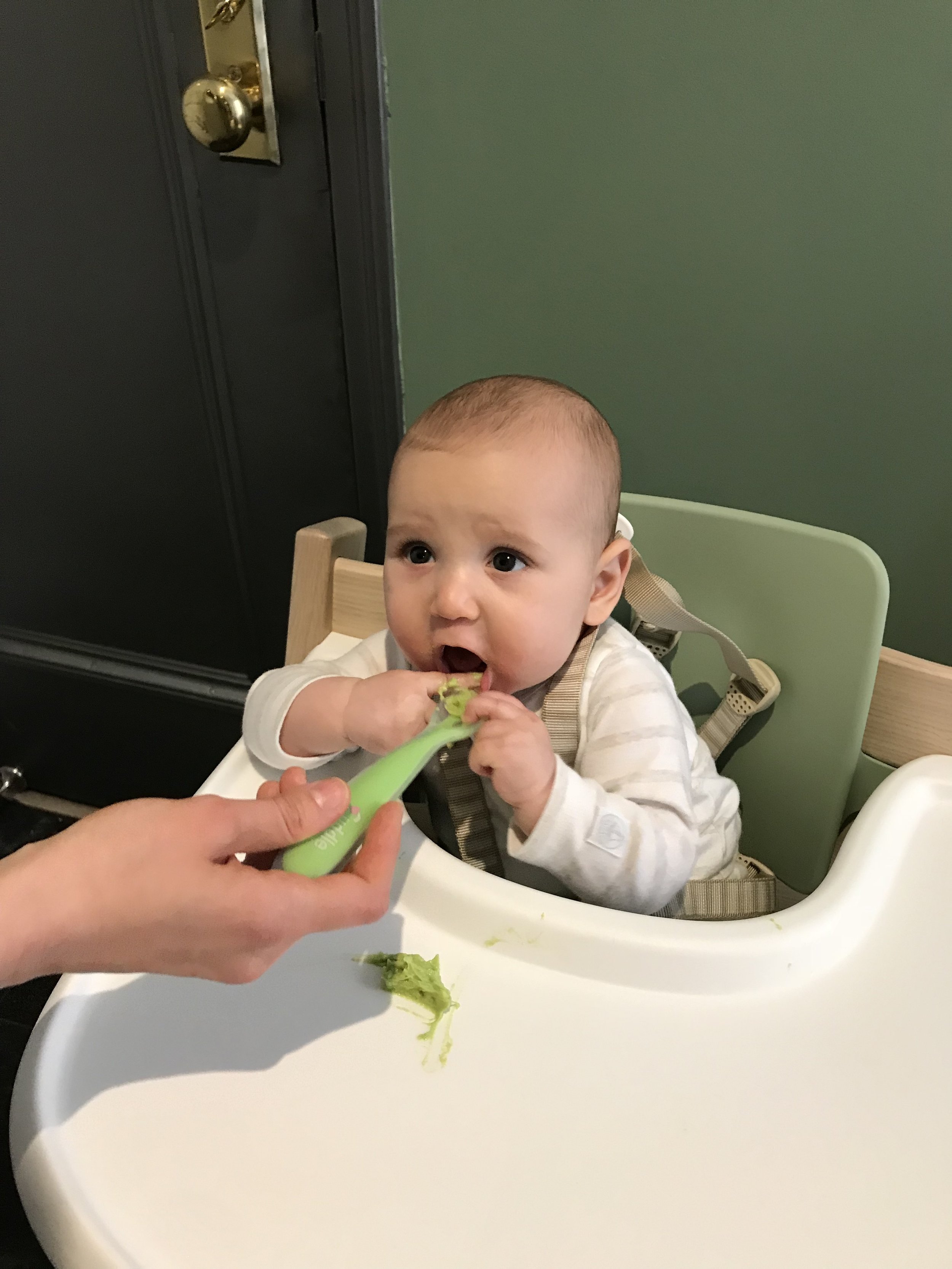Jack had his first tastes of solids at 5 1/2 months. It was smashed avocado, and the excitement on my end was not as well received by Jack. We got him comfortable with his chair (the Stokke Tripp Trapp), put on his bib, (happy healthy parent bib) showed him the whole avocado, mashed it with a fork, and offered it to him with a spoon (the numnum gootensil has been our go-to). His reaction was as if he had tasted something very sour. It was, after all, the first that time Jack had tasted real food with texture and flavor. Since that point, feeding Jack has been filled with tons of laughs, some stress, and lots and lots of clean up.
why I chose to do baby-led feeding
At Jack's 4 month visit, our pediatrician told us that Jack could start solids. After doing some research and wanting to go more toward the baby-led feeding approach, we waited until he was almost 6 months old. We did this because at 6 months of age, most babies are developmentally ready to self-feed. We skipped purees mainly because Jack was not interested in purees from early on and he always wanted to feed himself.
There are no hard and fast rules about feeding baby aside from avoiding potential choking hazards and introduction of allergens. Do what feels best for you and your families needs. Do a combo of purees and baby led feeding or choose whichever option is going to create the least amount of additional stress in your life, the least amount of anxiety, and convenience. Keep in mind to offer different textures. Baby may prefer one way over another. Try and choose organic produce when possible. Babies have smaller digestive systems and body mass so they can handle less toxins and pesticides than adults.
choking is the #1 concern parents have regarding baby -led feeding
I was on the fence about baby-led feeding, mainly due to fear of choking, but after a lot of self-education which included taking a baby CPR class, feeding littles online course, and reading Baby-Led Feeding, I felt empowered to go this route. I also saw how well Jack was doing and that he was learning to eat with confidence, developing fine motor skills, and getting pleasure in food. It is truly amazing seeing the ability that a baby has to eat. They are also powerful chewers, assuming the texture is correct - mashable on the roof of your mouth or between your two fingers. A large amount of chewing takes place in the back of the mouth, so the appearance of teeth should not make much of a difference in terms of whether you choose baby led feeding or not.
A vast amount of questions I get regarding this feeding approach is about choking. It was my main concern too, but it is important to note that gagging is part of the learning process, even though it can be a little scary at times. Consequently, it is essential to be educated and learn the difference between gagging and choking. Gagging is often accompanied with teary eyes, coughing, and noise. Choking is silent and may be accompanied by staring with an open mouth and waving hands. Therefore, it is key to only offer appropriate foods that are the correct shape and texture. I know that every child is different, and you have to do what is right for your baby, your sanity, and your lifestyle. Consult your pediatrician to help assess if your child is ready. These are guidelines for the general population who are growing as expected. If your child is medically fragile, has oral motor delays, or neurological delays, consider starting with purees, engage a speech language pathologist, registered dietitian, and of course consult your pediatrician. Most people learn how to eat one way or another. There is no ONE way to feed your child.
benefits of baby-led feeding
No buying jars or pouches or pureeing food
Self-regulation of hunger cues (baby stops eating when they are full)
Early inclusion into family meals (babies eat modified versions of what everyone else is eating)
Focus placed on whole real foods - no pouches, jars, boxes, or processed foods
Flexibility and freedom
Broadening baby's palate from early on (utilize a variety of spices and seasonings when preparing foods)
Integration of a variety of textures oppose to purees which are homogenous
Quicker development of fine motor skills/ form of sensory play
Less meal prep specifically for baby since everyone eats the same food as the family
Balanced diet
Establishes independence
Reduce the chance of picking eating by early exposure to a variety of tastes/textures/temperatures
When I knew we were ready
Some signs that baby is ready for solids is that they are showing interest in what you are eating, and baby can sit up and support themselves independently and/or has good head and neck control. Baby can track objects with their eyes and has the coordination to bring their hand to their mouth. When starting to introduce solids, you want to be sure that your baby is not too hungry or too tired. This can be a little complicated with scheduling in the early days but, ideally you want to feed baby solids an hour after a milk feed. At six months of age, babies do not have a pincer grasp, which means they are unable to pick up small pieces of food. They are developing the palmer grasp, which is being able to reposition food in their hands and open it. Initially, when selecting foods for baby led feeding, you want to offer foods that are in strips (length of your pinky) and can be grasped in the palm of baby's hand and can be mashed easily on the roof of your/baby's mouth. For the initial few weeks of baby led feeding, not much food may make it into your child’s stomach. Your child will be exploring and learning how to eat and establishing a new routine (and so will you).
*Every baby develops differently. Go at your baby's pace and, if you have any questions/concerns, consult your pediatrician.
Roasted sweet potato fries, raspberries, green pancake with peanut butter.
Organic Swiss cheese, sautéd spinach, kamut spirals with pesto, roasted zucchini, roasted sweet potatoes, and strawberries.
Easy first foods (6 months)
Benchmark of finger foods are the length and width of adult pinky, texture/softness is that food can be easily mashed between your fingers. Remember, your child needs to be able to easily chew with just their gums.
Once baby is 8 months and their skills are more developed, you can advance to smaller cuts of food (square shaped) which assists with their fine motor skills. A major benefit of this approach is that, in theory, you and baby can be eating the same foods.
simple ideas for 8 months and up
squished blueberries
raspberries
squished chickpeas
flaked salmon
hard boiled egg cut into quarters
squares of organic cheese
chopped strawberries
spiraled whole wheat pasta with sauce
chopped peach
strips of mango
shredded tender meat
toast strips with thin spread of nut butter or avocado
smoothie from open cup or straw
baked oatmeal squares
any roasted or steamed veggie cut into strips or squares
roasted apple slices
tender pinto/black/red beans slightly squished
whole wheat pita with bean dip
sautéed spinach
quinoa mixed with guacamole or bean dip on a loaded spoon
spinach muffins
Jack's Schedule
We started Jack on three meals a day around 6 months to help with his naps - which it did! But to be honest, three meals a day is A LOT of work. Start with one meal a day around 6 months and slowly progress to three meals a day by 9 months and three meals and two snacks by 12 months of age. Here is a his daily schedule for your reference. Reminder opt for solids 30 minutes to an hour after a milk feed.
6am - wake up
6:30am - milk feed
8am - breakfast
9am - nap
10:30am - milk feed
12pm - lunch
1pm - nap
3pm - milk feed
6pm - dinner
6:45pm - milk feed
7pm - bed
Recently I had to start integrating formula into Jack's milk feeds. My body has started to slow down on milk production, and I needed to make sure Jack was getting everything that he needed. Integrating formula came with a lot of mixed emotions, but ultimately we opted for Holle Formula, an organic formula from Germany.
Jack enjoying some corn on the cob for the first time.
Swiss cheese, squished blueberries, squished spice roasted chickpeas, steamed broccoli, roasted zucchini, and cantaloupe
Jack's Eats
My approach to feeding Jack is offering him real whole foods - avoiding anything that is in a package or that is processed. We eat very "simply" and so far that has been our feeding philosophy with Jack. Feeding a baby and adults is hard enough, so we try and keep it as simple and streamlined as possible. Sure you can get fancy with quinoa cakes and lentil loafs and I have tried those, but Jack has been most receptive to keeping it simple and whole. We shall see how that evolves once he is older. Establishing good eating habits early on by eating at the table together, introducing various flavors, textures, and temperatures helps establish a lifetime of confident eaters with a healthy relationship to food. Since life is HARD, and we can all use a helping hand - there are some great baby food brands currently available that provide organic options in varying textures. We can’t do it all and that’s ok!
Here are the typical offerings that Jack has on a weekly basis.
These items are very easy to prep, keep well in the fridge, we enjoy eating them, and so far are well received.
2 egg omelette with spinach and shredded cheese cut into strips, squares, or scrambled
toast strips with a thin layer of nut butter, avocado, or kite hill chive spread
fruit: banana "fingers" with almond butter, "santas" raspberries filled with cottage cheese or nut butter, kiwi cut into quarters, slightly squished blueberries, strawberries quartered, mango sliced, cantaloupe and watermelon sliced into strips
mashed chickpeas
steamed broccoli and cauliflower with hummus
steamed carrots
roasted zucchini
wild sardines low salt in olive oil
roasted wild salmon
pasta with pesto
cheese and spinach quesadillas with siete foods almond flour tortilla
stewed shredded chicken thighs
roasted sweet potato "fries" cooked in olive oil and various spices (cumin, cinnamon, coriander, turmeric)
roasted squash (acorn, butternut, carnival)
sliced avocado
full fat organic cottage cheese
turkey meatloaf
turkey meatsauce/meatballs
quinoa and black beans lightly mashed together
oatmeal on a loaded spoon
whole grain waffles or pancakes
We try to roast the vegetables with different spices so Jack can get a sense for various flavors. Cumin, garlic powder, oregano, turmeric, coriander, paprika are our "go-to's". To make things easier, we meal prep the veggies and protein on Sunday and buy lots of fruit, cheese, and eggs at the beginning of the week. We try to make quick meals off one or two shopping trips.
If you opt for purees or want to do a combination approach
Cook each item until very soft (either via steaming, blanching, boiling, or roasting).
Toss ingredients in a blender and add liquid—either the liquid you steamed food in, breast milk or water. As you progress with solids, add in some fat like coconut oil, olive oil, grass-fed butter, and herbs and spices.
Traditional puree introduction is done in phases:
At 6 months, purees should be thin, smooth, and watery. Use a food processor or blender to achieve the ideal consistency. You can add breast milk, formula, or water to thin it out. Ideal portion size per meal at 6 months is 1 teaspoon to 1 tablespoon. First purees can be single ingredient foods such as avocado, pear, sweet potato, broccoli, or carrot. After a few weeks combine foods and add in herbs and spices to start exciting the taste buds. Also, add in some fat like coconut oil, olive oil, grass-fed butter which is essential for optimal brain and eye development and assists in the absorption of fat-soluble vitamins. Adding various herbs and spices early on, helps to develop the palate and ideally creates adventurous eaters. Some spices to consider are cinnamon, ginger, garlic, cumin, and turmeric.
At 7 to 9 months, start progressing to thicker textures as you begin combining ingredients and introducing legumes, grains, meats, and dairy. Advance to 2 feedings of solids per day. Ideal portion size is 1/4 cup to 1/2 cup per feeding. Suggested combinations are spinach and sweet potato, beet and zucchini, avocado and white beans, quinoa and winter squash, kale and chicken, and green beans and tofu. Don’t forget your spices!
At 10 to 12 months, progress to chunky textures. Blend food or mash with a fork. You can also eliminate adding water, breast milk, or formula. Try offering soft pieces of food alongside the chunky puree such as flaked fish, scrambled eggs, or kiwi. Portion range is 1/4 cup to 1/2 cup per feeding. Advance to 3 meals and 2 snacks per day.
At 6 months of age you can also introduce a sippy cup or straw cup for water.
Be mindful of babies hunger cues do not force feed
Load a spoon and let baby bring spoon to mouth or place puree on babies tray and let baby have a sensory experience and self regulate what gets into their mouth. You can also spoon feed, but make sure baby is fully focused on what is taking place.
When you do spoon feed baby, put the spoon about 12 inches in front of baby and let baby lean in to eat. If they open their mouths for more give it to them, and if they close their mouths or look the other way, end the feeding and just have them play with the food and spoon! This allows baby autonomy and self regulation.
Avoid scraping babies face with spoon which can create negative association with eating
Progress to thicker textures by 9 months
Foods to avoid due to choking hazard until 4:
whole grapes, cherries, olives (can peel and quarter)
raw nuts
whole hot dogs
popcorn
marshmallows
raw apple or raw carrot
glob of nut butter
bones in fish
chicken or fish skin
chips
hard candy
Foods to avoid for the first year:
Avoid salting foods, use other spices
Honey due to risk of botulism
High mercury fish (tuna, swordfish, shark, king mackerel)
Cows milk (yogurt, kefir, butter, and cheese are ok). Cows milk has too much protein, potassium, and sodium for baby to process. Additionally it does not contain enough essential fatty acids, iron, or vitamin E as breast milk or formula.
In General Avoid:
Low fat/ fat free dairy – give full fat dairy for healthy brain and eye development
Caffeine
Food Dye
Refined sugars
Carrageenan
Sugary foods/desserts
“Sugar-Free”/Artificially sweetened
Allergens
The American Academy of Pediatrics now recommends introducing allergens beginning at 4 to 6 months. I recommend waiting until 6 months of age with signs of readiness. The early introduction of highly allergic foods may prevent food allergies in infants and that delayed introduction may increase the risk of a food allergy. Always check with your pediatrician if you have a strong family history or if your child is prone to eczema and has had intolerances from breastfeeding or formula. Introduce new potentially allergenic food in the morning or when your child will be up for a few hours so that you can carefully monitor your child throughout the day. Introduce the same new food consecutively, for 2 to 3 days, and then move on to next allergen. Once you have introduced the allergenic foods, mixing foods will be easier and is encouraged. If the baby shows signs of hives, rash, vomiting, swelling, or trouble breathing, call your pediatrician immediately.
Top 8 Allergenic Foods + ways to introduce them
I would love to hear about your feeding journey with your little person. Please continue the conversation below in the comments and I will continue answering and sharing our journey.
Thanks for reading.
Jack chowing down on grilled asparagus at a BBQ
Jack enjoying spaghetti with kale pesto, kiwi, and roasted zucchini.

















